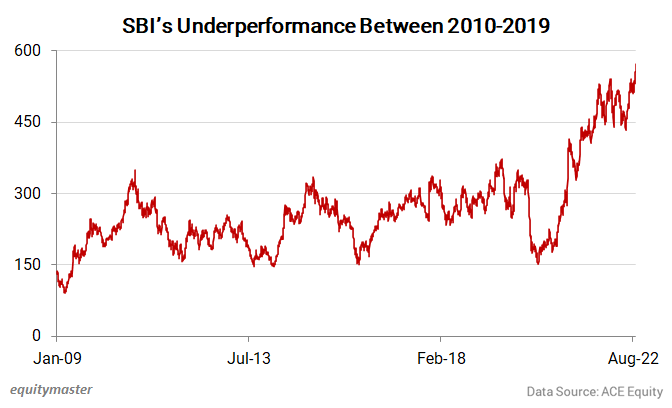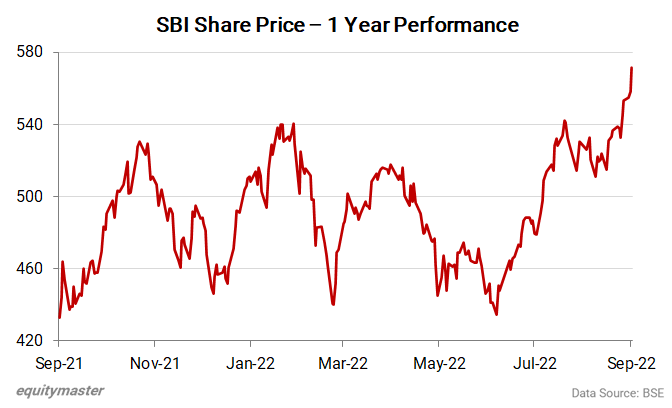India's Third Giant Leap
This Could be One of the Biggest Opportunities for Investors
- Home
- Views On News
- Sep 16, 2022 - Why SBI Share Price is Rising
Why SBI Share Price is Rising

You go to your office, and your boss tells you to go home, and have a week of paid leave.
You want to order some food, and while browsing menus on Zomato, you get a 100% discount on any order.
Or you go to a travel site, and get tickets to your favourite vacation spot for free.
All the above scenarios are not only too good to be true, but also fictional. Similarly, I have news that is too good to be true...and yet true.
It's about India's largest bank State Bank of India (SBI).
After a decade of underperformance, the share price of SBI has woken up. It's experiencing a similar breakout like ITC, Coal India, among other stocks.
All these stocks are known for underperforming for many years by trading around the same level.
Take SBI for instance. See the chart below which shows the company's performance between 2010 and 2019. It has traded in a range throughout this period and never broke above the Rs 400 mark.

But now, things have turned around for the largest bank and the stock is on a roll.
The marketcap of SBI surpassed Rs 5 tn earlier this week! Yes, that happened. SBI share price hit its lifetime high of Rs 571.6.
SBI share price has been rallying for a while now. In less than three months, SBI's share price rose more than 32%.

Let's find out the probable causes behind the recent rally...
#1 Rising interest rates
The reserve bank of India (RBI) has been raising repo rates to control inflation. In fact, not just the Indian central bank, but banks around the world have been increasing interest rates.
This has made loans costly. Businesses across the globe are suffering from the rising interest rate scenario. However, there is one sector that has rejoiced.
It's the banking sector. This is because for the banking sector, rising interest rates meant increased income.
Higher interest rates lead to higher margins and this could be one reason SBI share price is rising.
Owing to rising interest rates, not just SBI but the entire banking pack has performed well. Take a look at the table below to see the performance of best banking stocks in India.
| Bank Name | 1 Month (%) | 3 Months (%) |
|---|---|---|
| AU Small Finance Bank Ltd. | 7% | 9% |
| Axis Bank Ltd. | 3% | 24% |
| Bandhan Bank Ltd. | 9% | -2% |
| Bank Of Baroda | 15% | 44% |
| HDFC Bank Ltd. | 1% | 19% |
| ICICI Bank Ltd. | 4% | 35% |
| IndusInd Bank Ltd. | 10% | 48% |
| Kotak Mahindra Bank Ltd. | 5% | 15% |
| State Bank Of India | 9% | 30% |
| The Federal Bank Ltd. | 11% | 40% |
The covid-19 situation hampered businesses around the world. The banking business was also under pressure. This is because the demand for loans dropped.
However, as the covid-19 situation is slowly easing, businesses are reviving and so is the banking sector.
The economy is growing rapidly and so is the demand for loans. As more people invest in their businesses, they want more loans from banks.
Also, India recently surpassed the UK and saw a growth in its GDP. The market is expecting demand for loans to grow in the near term.
Rising interest rate scenario bodes well for the entire banking sector.
#2 Improvement in asset quality
When the margins of bank increase, they can write off the provisions made for loans. Hence when provisions are written off the balance sheet, the bank reflects a better position.
Growing GDP numbers suggests a higher money circulation. Hence, it is expected that recoveries of loans will be higher.
Hence, it is assumed that as the economy grows, the non-performing loans will reduce. This will be either due to recoveries of loans or because of the write-back of provisions.
SBI's non-performing assets (NPAs) have reduced substantially in the past five years.
SBI NPA Over the Years
| Particulars | FY22 | FY21 | FY20 | FY19 | FY18 |
|---|---|---|---|---|---|
| i) Gross NPA | 112,023 | 126,389 | 149,092 | 172,750 | 223,427 |
| ii) Net NPA | 27,966 | 36,810 | 51,871 | 65,895 | 110,855 |
| i) % of Gross NPA | 3.9% | 5.0% | 615.0% | 753.0% | 1091.0% |
| ii) % of Net NPA | 1.0% | 1.5% | 223.0% | 301.0% | 573.0% |
#3 Turnaround in capex cycle
Of late, there's an expectation of a turnaround in private capital expenditure. This has also improved sentiment for Indian banking stocks.
In this year's budget, the government announced a 35% increase YoY in infrastructure capex. The government has emphasised the growth of infrastructure to boost the economy.
If capex has to pick up, funding is required. A proxy play to capex is banking stocks which have a higher share in corporate lending, and not on retail customers.
SBI, which has been actively funding capex for infrastructure, is set to be one of the biggest beneficiaries as the capex boom plays out.
For instance, the Adani group last year readied plans for a Rs 150-bn funding from SBI for its Navi Mumbai airport. This is one of the largest project financing loans, signaling the return of capex loans for infrastructure projects.
This is just one example.
Given its ability to leverage leadership position, SBI is seen as the largest beneficiary of India's economic growth.
Investment Takeaway
- Strong credit growth along with rise in lending rates have come at a time when NPA levels have moderated, and treasury incomes are high.
Therefore, higher than expected profit growth is given in the near term. Over time once deposit rates also catch up with the lending rates, the lending margins may moderate.
This is what Co-head of Research at Equitymaster Tanushree Banerjee said when we reached out to her, for views on the banking sector.
In fact, Tanushree had already predicted that the coming quarters for banking sector stocks will be good.
Read here editorial to know why: Bank Stocks in 2022 Mirror Warren Buffett's 1989 Wells Fargo Investment.
SBI is the father of all Indian banks. Hence, when the banking sector faces headwinds or tailwinds, SBI will be the first one to feel the effect.
However, an investor has to tread carefully. Because the tailwinds of rising interest rates may not last long.
When interest rate rise and loans get costlier, there is a chance that loan defaulters will increase. If that happens, a domino effect will be created, and all the positives of the banking sector will turn into negatives.
On the other hand, FIIs have marginally reduced their share in SBI. In the last four quarters, FIIs have sold 0.9% of their stake in SBI.
SBI's financial performance has also been improving over the past couple of years.
Take a look at the table below.
Financial Snapshot
| Particulars (Rs in m) | FY18 | FY19 | FY20 | FY21 | FY22 |
|---|---|---|---|---|---|
| Total Income | 3,065,277 | 3,306,874 | 3,680,106 | 3,853,379 | 4,069,731 |
| Growth | 3% | 8% | 11% | 5% | 6% |
| Operating profit | -122,338 | 59,293 | 300,517 | 328,088 | 497,356 |
| Operating profit margin | -4% | 2% | 8% | 9% | 12% |
| Net profit | -41,874 | 30,691 | 181,768 | 242,797 | 363,562 |
| Net profit margin | -1% | 1% | 5% | 6% | 9% |
To conclude, public sector bank stocks are often considered to be value destroyers in the long run.
The biggest problem for PSU banks is not allocating 'other people's money' judiciously. Banks lend other people's money. Bad lending leads to NPAs which then needs to be provided for and erode the bank's net worth.
But now, the stage is set for PSBs. After a decade of underperformance, they are turning tables.
To know more about SBI, check out its factsheet and latest quarterly results.
You can also compare SBI with its peers:
Happy Investing!
Disclaimer: This article is for information purposes only. It is not a stock recommendation and should not be treated as such. Learn more about our recommendation services here...


Equitymaster requests your view! Post a comment on "Why SBI Share Price is Rising". Click here!
Comments are moderated by Equitymaster, in accordance with the Terms of Use, and may not appear
on this article until they have been reviewed and deemed appropriate for posting.
In the meantime, you may want to share this article with your friends!